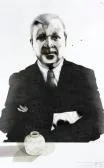
Demarcated by two neat, horizontal, ruler drawn lines, constellations of pinholes dot each corner of Storm Tharp’s exquisitely drawn large-scale portraits. This small detail is easy to overlook. Enigmatic and masterfully drawn, Tharp’s portraits are visually seductive, exploiting the material play of ink on water to form rich black pools and smoky washes as their starting point. But Tharp never loses sight of the link between the work and the labor involved in its creation. The residues of the studio—holes from the repeated pinning up and taking down of his canvases, color swatches, working titles, and the occasional note penciled into the margins—serve as a reminder that each drawing merely represents a pause to the greater durational performance that is Tharp’s artistic practice.
The nine pieces that comprise Tharp’s Hercules pull freely from an array of sources including pop culture, fashion, film, art, and autobiography [PDX Contemporary Art; June 1-26, 2010]. Highly-worked portraits that demonstrate Tharp’s skill as draftsman appear alongside loose sketches and abstract color fields. The exhibition is at once a nod to Minimalism, an exploration of the idea of perfection in classical Chinese and Greek thought, and an examination of the artist’s relationship to abstraction, realism, and the creative quest.
The five portraits that dominate the exhibition are among Tharp’s most restrained, eschewing the surrealism and distortion that characterize much of his earlier work. The flamboyant costumes that bedeck the figures of earlier portraits are replaced by minimal, abstracted shrouds. The Decorator, 2010, is a mash-up of the suicidal artist/mother-figure in Woody Allen’s late-1970s drama, Interiors, and the austerely garbed subject of Whistler’s mother. The figure gazes coolly out at us. Her black dress’ tight, horizontal hatch marks create an oppressive and featureless void that seems to pin her firmly to the two-dimensional plane, in contrast to the contours of her face and luscious folds of the blue silk shirt that gathers at her neck.
In Groton House, 2010, a portrait based on abstract painter, Eleanore Mikus—Tharp’s professor at Cornell University—a semi-opaque veil of graphite obscures the subject’s eyes. Reminiscent of Mikus’ textures and compositions, the marks threaten to flatten and conceal the figure’s face. Tharp further plays with the conceit of the artist being subsumed by his own work in the black-on-black portrait Man Behind a Desk, 2010, one of three works depicting Ad Reinhardt. The figure’s ghostly silhouette disappears into a heavy charcoal wash, transfigured through abstraction.
Flanking opposite walls of the gallery, the other two portraits of Reinhardt—Abstract Painter with Ginger Pot, 2010, and Abstract Painter with Peony, 2010—are nearly mirror images of one another. Like the two color field diptychs that provide a counterpoint to the portraits in the exhibition—the blushing stretched paper canvases of Vreeland, 2010, and the vibrant pink washes of Perfect, 2010—the duplication allows one to discern slight variations. Both portraits show a contemplative Reinhardt sitting behind a desk in black suit and tie, arms crossed, a single prop in the foreground. Lavish attention is given to details like the hem of the figure’s collar and the texture of his close-cropped hair, meticulously drawn strand by strand. Tharp seems to relish in the exercise of re-inserting an abstractionist into the world of representation, paying homage to Reinhardt not as a modernist emblem of clear thinking and pure abstraction, but as a complex, mutable, humanized figure.
- Katherine Bovee